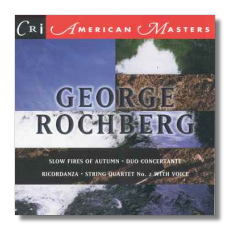
The Internet's Premier Classical Music Source
Related Links
- Rochberg Reviews
- Latest Reviews
- More Reviews
-
By Composer
-
Collections
DVD & Blu-ray
Books
Concert Reviews
Articles/Interviews
Software
Audio
Search Amazon
Recommended Links
Site News
 CD Review
CD Review
George Rochberg

Volume 2
- Slow Fires of Autumn (Ukiyo-e II) (1978-79) 1
- Duo Concertante (1955; revised 1959) 2
- Ricordanza (Soliloquy) (1972) 3
- String Quartet #2 (1959-61) 4
1 Carol Wincenc, flute
1 Nancy Allen, harp
2 Mark Sokol, violin
2,3 Norman Fischer, cello
3 George Rochberg, piano
4 Janet Harsanyi, soprano
4 The Philadelphia String Quartet
Recordings originally produced by Carter Harman, except Quartet #2
CRI American Masters CD769 ADD 72:47
Originally released on:
CRI SD436 (Slow Fires of Autumn)
CRI SD337 (Duo and Ricordanza)
CRI SD164 (Quartet #2)
The second volume of CRI's reissues of the music of George Rochberg gives us a broader overview of his styles than did the first disc.
This collection includes two atonal works from the 1950's, a neo-romantic exercise from the early 1970's, and a piece of oriental exotica from the late 1970's.
Slow Fires of Autumn, scored for flute and harp, uses classical Japanese scales and instrumentation, with the Western harp substituting for the traditional koto. The work opens quietly, with the harp providing a foundation for the flute's excursions. Like Debussy, this music evokes the "floating world," but Rochberg is much closer to the Japanese in sound and structure where the French Impressionist translated this into European musical language. Instead, Rochberg starts with the Japanese style as a base and adds Western elements. The motifs and other patterns used here derive from the European tradition and are well integrated into a basically Eastern fabric. The effect is peaceful and serene. There is no clash of cultures here as East meets West.
The Duo Concertante, from twenty years earlier, is stern, strenuous, insistent, systematic atonal music. A forceful beginning leads to quieter episodes of wistful, melancholy questioning. The two voices always work together to present the material, cooperating and rarely trading lines or conversing. Sometimes a phrase or line is handed off midway from one to the other giving the definite impression of teamwork and an equal partnership. The overall structure is alternating fast and slow passages, declarative and interrogative voices.
The questions that this music asks seem to arise from pain and sadness – why is life this way? - and the attempts to reply are earnest but mostly hollow and dogmatic. Uncertainty prevails and a gloom hovers, leaving us with restlessness from the failed attempts to find an answer.
Ricordanza, for cello and piano, could almost be mistaken for a lost sketch for a cello sonata by Rachmaninoff or Brahms. It is an overtly tonal slow movement with limited scope and little drama, and monochrome mood. Pleasant enough, in a very late or neo-romantic style, it follows a conventional structure of exposition, development, and recapitulation. (There's even a cadenza.) The harmonies seem to stay very close to the home key, as if afraid to stray too far. It feels like an echo of a lost time, and we cannot hear it without being reminded of the historical context and references. But this exercise breaks no new ground. By following its models faithfully it fails to say anything new.
The Quartet #2 is a large and complex work. It is made up of four sections without explicit breaks into movements: an instrumental introduction, two sections with voice and an instrumental interlude between these. It starts with pizzicato chattering, a conference of birds. A seven-note cell provides the basis for the piece and is elaborated in various registers and voicings. This basic material is taken apart, reassembled, twisted, stretched, and always asserts its strength, as it is recognizable through these transformations. Played slowly it carries great weight, played quickly it transmits plenty of energy. Rochberg makes much use of the contrast between fast and slow traversal here.
In the main body of the work, the soprano voice intones words from Rilke's "Duino Élégies" and brings the highly abstract material of the opening section into direct contact with the world of human emotions. The words are in English but they are largely unintelligible - we hear mostly vowel sounds. With the entry of the voice, the atmosphere coalesces into a mood of searching optimism which gradually gives way to a gloom bordering on despair. The instrumental interlude is busy, insistent, driven, and when the voice returns it brings a feeling of contemplation, then high drama and seriousness. The work ends on a quiet note, having found some resolution and, with it, peace. But there remains a deep sense of mystery when the sounds have ended. I know that some important matter has been raised, considered, and explored at length but I do not yet know what it is or what it means. Perhaps when I have heard the piece a few more times it will be clearer.
I expect to return to all of these pieces from time to time to explore further the riches they have to offer and to contemplate the mysteries they contain. These important and challenging works hold much meaning and will reward the patient listener.
Copyright © 1997, Paul Geffen


















